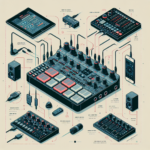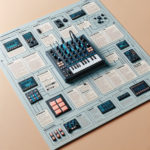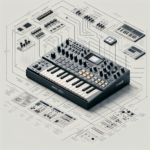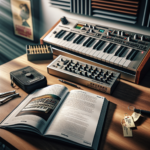Ableton Push 1: Comprehensive Guide to Features, Setup, and Performance
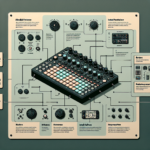
Introduction
The Ableton Push 1 is a versatile MIDI controller designed to enhance the music production experience, particularly for users of Ableton Live. It serves as a tactile interface that allows musicians and producers to create, perform, and produce music more intuitively. Targeted at both beginners and professionals, the Push 1 aims to streamline the workflow and make music creation more accessible.
Ableton, the brand behind Push 1, is renowned in the music industry for its innovative software and hardware solutions. Known for its flagship DAW, Ableton Live, the company has built a strong reputation for quality and reliability.
Key Features Overview:
- 64 velocity-sensitive pads
- 11 touch-sensitive encoders
- Integrated display for real-time feedback
- Seamless integration with Ableton Live
- Advanced features like aftertouch and step sequencing
Design and Build Quality
Physical Design
The Ableton Push 1 boasts a sleek and modern design, featuring a grid of 64 velocity-sensitive pads that are backlit with RGB LEDs. The controller measures approximately 14.5 x 11.5 x 1.5 inches and weighs around 6.6 pounds, making it a substantial yet manageable piece of equipment. The materials used include a combination of high-quality plastic and metal, ensuring both durability and a premium feel.
Portability
While the Push 1 is not the most portable MIDI controller on the market, its size and weight make it relatively easy to transport for gigs or studio sessions. It fits comfortably in most backpacks designed for music equipment, and its robust build ensures it can withstand the rigors of travel.
Durability
The build quality of the Push 1 is impressive, with a sturdy construction that can endure regular use. The pads and encoders are designed to be responsive and durable, ensuring they remain functional even after extensive use. The overall design is robust, making it a reliable choice for both studio and live performance settings.
Setup and Configuration
Initial Setup
- Unbox the Ableton Push 1 and connect it to your computer using the provided USB cable.
- Power on the controller by connecting it to a power source if required.
- Launch Ableton Live on your computer.
- Navigate to the Preferences menu in Ableton Live and select the MIDI/Sync tab.
- Ensure that the Push 1 is recognized and enabled as a control surface.
Software Installation
The Ableton Push 1 is designed to work seamlessly with Ableton Live, and no additional drivers are typically required. However, it is recommended to ensure that you are using the latest version of Ableton Live for optimal performance. If any firmware updates are available for the Push 1, follow the instructions provided by Ableton to install them.
Compatibility
The Ableton Push 1 is compatible with both Windows and macOS operating systems. It integrates seamlessly with Ableton Live, but it can also be used with other DAWs such as FL Studio, Logic Pro, and Cubase through MIDI mapping. However, the full range of features is best experienced when used with Ableton Live.
Features and Functionality
Key Features
The Push 1 is equipped with 64 velocity-sensitive pads that can be used for playing drums, triggering samples, and creating melodies. The 11 touch-sensitive encoders allow for precise control over various parameters, and the integrated display provides real-time feedback, making it easier to navigate and control your projects.
Customizability
Users can customize the Push 1 through MIDI mapping, allowing them to assign different functions to the pads and encoders. This flexibility makes it possible to tailor the controller to suit individual workflows and preferences. Additionally, users can create custom scripts to further enhance the functionality of the Push 1.
Unique Functions
One of the standout features of the Push 1 is its step sequencing capability, which allows users to create intricate patterns and sequences with ease. The controller also supports aftertouch, enabling more expressive performances. The chord mode is another unique function that simplifies the process of creating harmonies and chord progressions.
Integration with DAWs
The Push 1 integrates seamlessly with Ableton Live, providing a hands-on experience that enhances the workflow. Users can navigate through their projects, control various parameters, and perform live without needing to touch their computer. While it can be used with other DAWs, the integration is most comprehensive with Ableton Live.
Advanced Features
The Push 1 offers several advanced features, including aftertouch, which allows for more expressive playing by responding to the pressure applied to the pads. The arpeggiator function enables users to create complex arpeggios with ease, and the chord mode simplifies the process of playing chords. These features make the Push 1 a powerful tool for both production and performance.
Performance
Latency and Responsiveness
The Push 1 is known for its low latency and high responsiveness, making it a reliable choice for both studio and live performance settings. The velocity-sensitive pads are highly responsive, allowing for dynamic and expressive playing. The touch-sensitive encoders provide precise control over various parameters, ensuring a smooth and intuitive experience.
Real-World Usage
In practical scenarios, the Push 1 performs exceptionally well. In a studio setting, it streamlines the workflow by providing a hands-on interface for controlling Ableton Live. During live performances, the Push 1 offers a reliable and intuitive way to trigger samples, play instruments, and control effects. Its robust build ensures it can withstand the demands of live use.
User Experience
Overall, users have reported positive experiences with the Push 1. The controller is praised for its intuitive design, seamless integration with Ableton Live, and robust build quality. Some users have noted a learning curve when first using the controller, but most find it to be a valuable addition to their setup once they become familiar with its features.
Applications and Use Cases
Beginner vs. Professional Use
The Push 1 is suitable for both beginners and professionals. Beginners will appreciate its intuitive design and seamless integration with Ableton Live, which makes it easier to get started with music production. Professionals will benefit from its advanced features and robust build quality, making it a reliable tool for both studio and live use.
Studio Use
In a studio environment, the Push 1 excels as a hands-on interface for controlling Ableton Live. It streamlines the workflow by providing quick access to various functions and parameters, making it easier to create and produce music. The step sequencing and chord mode features are particularly useful for creating complex patterns and harmonies.
Live Performance
The Push 1 is also well-suited for live performances. Its robust build ensures it can withstand the demands of live use, and its intuitive design makes it easy to trigger samples, play instruments, and control effects in real-time. The low latency and high responsiveness of the pads and encoders make it a reliable choice for live settings.
Specific Genres
The Push 1 is versatile enough to be used in a variety of genres, but it particularly excels in electronic music genres such as EDM, hip-hop, and techno. Its step sequencing and arpeggiator features make it ideal for creating intricate patterns and sequences, while the chord mode simplifies the process of creating harmonies and chord progressions.
Pros and Cons
Pros:
- Seamless integration with Ableton Live
- 64 velocity-sensitive pads
- 11 touch-sensitive encoders
- Robust build quality
- Advanced features like aftertouch and step sequencing
Cons:
- Not the most portable option
- Learning curve for beginners
- Full range of features best experienced with Ableton Live
Common Issues and Troubleshooting
Known Issues
Some users have reported issues with the pads becoming less responsive over time. Additionally, there have been occasional reports of connectivity issues when using the Push 1 with certain computers or operating systems.
Troubleshooting Tips
- If the pads become less responsive, try recalibrating them through the settings menu in Ableton Live.
- If you experience connectivity issues, ensure that you are using the latest version of Ableton Live and that your operating system is up to date.
- Restarting both the Push 1 and your computer can often resolve connectivity issues.
Customer Support
Ableton is known for its excellent customer support. Users can access a wealth of resources on the Ableton website, including user manuals, tutorials, and a comprehensive knowledge base. Additionally, Ableton offers direct customer support through email and phone, ensuring that users can get help with any issues they may encounter.
Comparisons with Similar Controllers
Competitor Comparison
When compared to similar controllers from other brands, the Push 1 stands out for its seamless integration with Ableton Live. While other controllers, such as the Novation Launchpad and Akai APC40, offer similar features, the Push 1 provides a more intuitive and streamlined experience for Ableton Live users.
Feature Comparison
In terms of features, the Push 1 offers a comprehensive set of tools for music production and performance. Its 64 velocity-sensitive pads, 11 touch-sensitive encoders, and integrated display provide a high level of control and flexibility. While other controllers may offer similar features, the Push 1’s advanced functions, such as aftertouch and step sequencing, set it apart from the competition.
Conclusion
Summary
The Ableton Push 1 is a versatile and powerful MIDI controller that offers a comprehensive set of features for music production and performance. Its seamless integration with Ableton Live, robust build quality, and advanced functions make it a valuable tool for both beginners and professionals.
Who Should Buy This?
The Push 1 is best suited for users of Ableton Live who are looking for a hands-on interface to enhance their workflow. It is suitable for both beginners and professionals, offering a range of features that cater to different skill levels and use cases.
Final Thoughts
Overall, the Ableton Push 1 is a reliable and intuitive MIDI controller that offers a high level of control and flexibility. Its advanced features and seamless integration with Ableton Live make it a valuable addition to any music production setup.
FAQ
Is the Ableton Push 1 compatible with other DAWs?
Yes, the Push 1 can be used with other DAWs through MIDI mapping, but the full range of features is best experienced with Ableton Live.
Do I need to install any drivers to use the Push 1?
No, the Push 1 is designed to work seamlessly with Ableton Live without the need for additional drivers. However, it is recommended to use the latest version of Ableton Live for optimal performance.
Can I use the Push 1 for live performances?
Yes, the Push 1 is well-suited for live performances. Its robust build and intuitive design make it a reliable choice for triggering samples, playing instruments, and controlling effects in real-time.
What operating systems are compatible with the Push 1?
The Push 1 is compatible with both Windows and macOS operating systems.
How do I customize the functions of the Push 1?
Users can customize the Push 1 through MIDI mapping, allowing them to assign different functions to the pads and encoders. Additionally, custom scripts can be created to further enhance the functionality of the controller.
Where to Buy
The Ableton Push 1 can be purchased from various retailers, including major music equipment stores and online marketplaces. Some of the well-known retailers that carry the Push 1 include Guitar Center, Sweetwater, and Amazon. Additionally, it can be purchased directly from the Ableton website.

